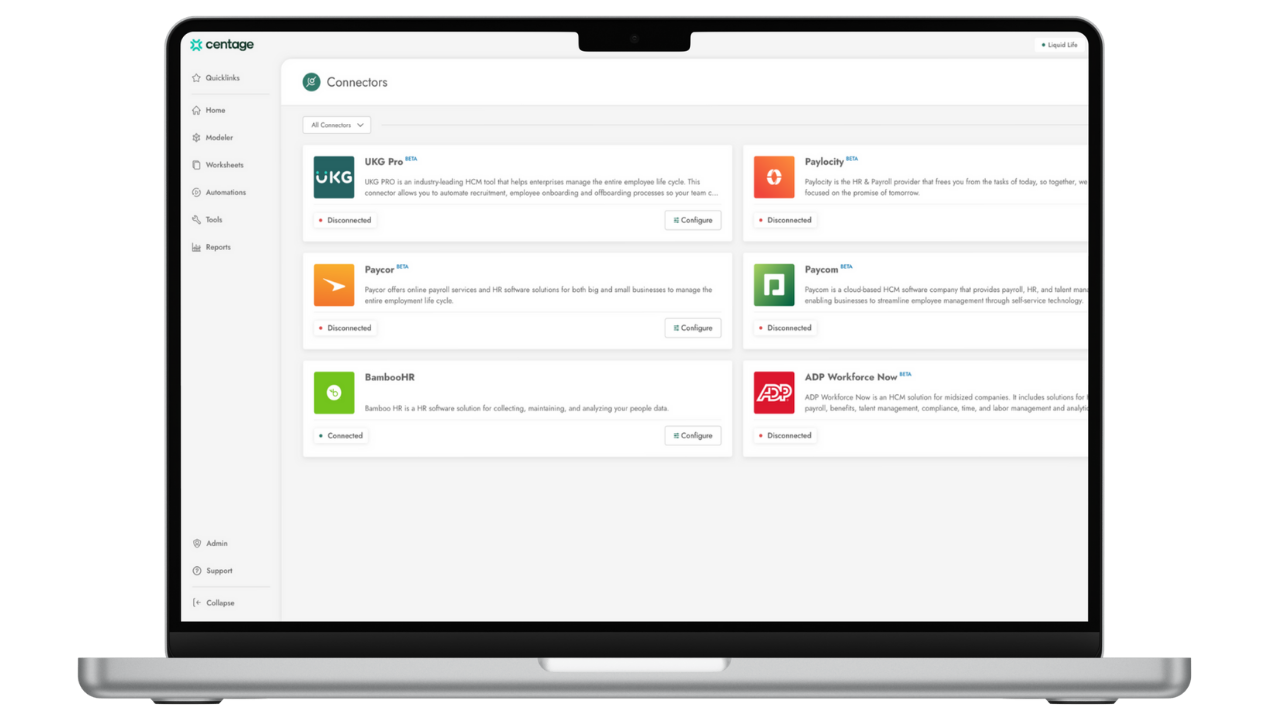Our Resources
FP&A Insights
Blogs, webinars, and whitepapers to help optimize your FP&A performance.
Thank you! Your submission has been received!
Oops! Something went wrong while submitting the form.

Workforce Planning
Centage
Thought Leadership
July 14, 2025
Podcast Recap: What Every CFO Needs to Know About Workforce Planning

Scenario Planning
Budgeting
Forecasting
July 9, 2025
Why Scenario Planning Is Critical for Resilient CFOs

Workforce Planning
Centage
FP&A Software
May 22, 2025
Payroll Integrations Are Live: Real-Time Workforce Data, Zero Spreadsheets

Thought Leadership
Scenario Planning
April 28, 2025
How to Calculate the ROI of AI: A Guide for Finance Leaders (2025 Edition)

Centage
Scenario Planning
Thought Leadership
April 9, 2025
How to Financially Model the Impact of Tariffs (2025 Edition)

Centage
FP&A Software
April 7, 2025
From Spreadsheets to Superpowers: Introducing the New Centage Worksheets

Centage
FP&A Software
Budgeting
Forecasting
Reporting
April 2, 2025
Top 10 Financial Performance Management (FPM) Software Tools for 2025: Features, Comparisons, and How to Choose the Best One

Centage
FP&A Software
Thought Leadership
March 20, 2025
I Crowdsourced the Challenges FP&A Teams Are Having with Excel—Here’s What I Found

FP&A Software
Scenario Planning
Thought Leadership
March 17, 2025
How to Build a Financial Model: A Step-by-Step Guide for Finance Teams
.png)
FP&A Software
Forecasting
February 28, 2025
Smarter Forecasting, Stronger Decisions: How Modern FP&A Tools Drive Success
.png)
Forecasting
FP&A Software
February 20, 2025
Top Financial Forecasting Software Compared: Features, Strengths & Trade-Offs
.png)
Budgeting
Centage
FP&A Software
February 5, 2025
Budgeting Nightmares & How to Avoid Them: Lessons from FP&A Experts
.png)
Budgeting
FP&A Software
January 28, 2025
Budgeting Together: Tools and Best Practices For Collaborative Budgeting
.png)
Scenario Planning
Budgeting
January 2, 2025
New Year, New Goals: 5 Key Priorities for FP&A Professionals in 2025
.png)
Forecasting
FP&A Software
December 11, 2024
Breaking Free from Annual Budgets: Why Rolling Forecasts Are the Future
.png)
Budgeting
Forecasting
Scenario Planning
December 3, 2024
Get Your Master’s in Education Budgeting: A Crash Course for Financial Success
.png)
Budgeting
FP&A Software
Workforce Planning
November 18, 2024
The Budgeting Dojo: Mastering Financial Moves in Manufacturing
.png)
Budgeting
Workforce Planning
Forecasting
November 7, 2024
Don’t Forget This Key Change in Workforce Planning for 2025: New Social Security Wage Base

Budgeting
Forecasting
FP&A Software
November 1, 2024
5 Proven Strategies to Make Budgeting & Forecasting Less Painful for CFOs
.png)
Budgeting
October 29, 2024
Warding Off Financial Frights: Strategies for Secure and Collaborative Budgeting
.jpg)
FP&A Software
Budgeting
October 28, 2024
Expert Q&A: How to Prepare for Implementing an FP&A Budgeting and Forecasting Software
No Results Found
Reset Filters







.png)
.png)

.png)
.png)
.png)
.png)
.png)
.png)
.png)
.png)
.png)
.png)

.png)
.png)




.jpg)






















































%20(Large).png)

.jpeg)













